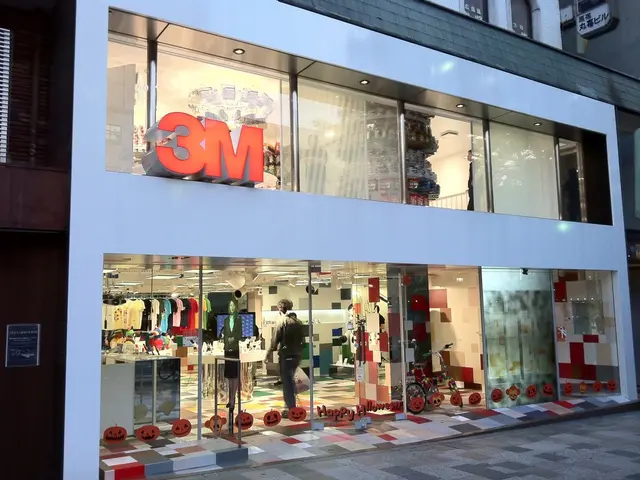Updated Mobile Application Statistics: Market Expansion and Usage Trends (2025 Data)
In the digital age, mobile applications have become an integral part of our daily lives. Here's a glimpse into the current state of the app market, based on recent statistics.
The average time required to develop an application is approximately four and a half months. This figure, however, can vary depending on the complexity of the app and the features it offers.
Once developed, updates are crucial for maintaining user engagement. Over half of the 100 most successful apps push an update every ten days, ensuring they stay relevant and functional.
The app market is thriving, with significant growth projected in the coming years. In 2027, the spending on the Apple App Store is expected to reach 125 billion US dollars, while combined user spending in the App Store and Google Play is estimated to reach almost 186 billion US dollars.
Multi-channel marketing is essential in today's connected world. Ninety-eight percent of American consumers switch between devices every day, and 60 percent of millennials expect consistent brand experiences across every channel.
Mobile phones account for the highest number of visits and orders on retail sites. Smartphones generate approximately 74 percent of retail site traffic worldwide and 63 percent of online shopping orders.
Social apps, entertainment apps, and productivity apps are expected to continue growing as the top non-gaming app categories across app stores. Social and entertainment will likely tie for a six percent revenue share in 2026.
The app store page view to install rate is 33.7 percent on the App Store, and 26.4 percent on Google Play. This indicates that a significant number of users are converting after viewing an app's page.
Online travel bookings have surpassed previous records, with a booking value of 798 billion US dollars in 2022. Customer Acquisition Costs (CAC) have risen by 60% in the last five years to an average of 29 US dollars per user.
The global ride-sharing market is expected to grow by more than 133 percent between 2022 and 2028, with a value of around 226 billion US dollars in 2028.
Users spend an average of 4.6 to 5 minutes on shopping and retail apps, with the cumulative time spent on retail apps reaching 100 billion hours globally. The global mobile payment market is projected to grow from 2.98 trillion US dollars in 2023 to 18.84 trillion US dollars by 2030.
Lack of user-friendliness is one of the biggest reasons behind mobile site and mobile app abandonments. About 43 percent of users are unhappy if an app takes more than three seconds to load. If an app's overall performance is not good, 52 percent of users are frustrated by it and this can lead to uninstallations.
Many major companies have developed their own mobile apps. German companies like Deutsche Telekom, 1&1, Vodafone, Telefónica O2, Rewe, and Spar have apps mainly in the categories of telecommunications service apps and retail/customer loyalty apps.
About 54 percent of marketers use a mobile app platform to market to customers and prospects. More than half (47 percent) of all online stores have invested in one or more apps. Around 45 percent have invested in both Android and iOS apps.
The global online travel booking service market size was valued at 519.1 billion US dollars in 2021 and is expected to expand at a compound annual growth rate of 9 percent from 2022 to 2030.
In 2022, mobile advertising spending reached a record 327 billion US dollars worldwide, with this figure expected to reach around 400 billion by 2024. In 2026, consumers are projected to download 143 billion mobile apps from the Google Play Store, up by almost 30 percent from 111 billion apps downloaded in 2021. Similarly, the Apple App Store is expected to generate 38 billion downloads, an increase of around 15 percent in five years.
The number of travel app users in 2022 was slightly over one billion. 85 percent of consumers of top eCommerce platforms like Amazon favor shopping on mobile applications over mobile websites, with millennials especially embracing in-app shopping.
About 37 percent of millennials consider data usage as an important factor in deciding if they should download and use an app. About 58 percent of users say that they are frustrated by inconsistencies in an app's interface.
Among the top 10 Android apps, Google owns five, Meta Platforms owns three, and Amazon and Samsung own one app each. About 58 percent of users say that they are frustrated by inconsistencies in an app's interface.
Not having technical knowledge or workforce (50 percent), lack of time (23 percent), expensive processes (22 percent), and security concerns (5 percent) are the biggest challenges in app development.
About 71 percent of uninstalls are caused by app crashes. About 29 percent of users tend to abandon apps right away if they don't find any value in the app. Around 60 percent of mobile users subscribe to push notifications.
About 51 percent of users learn about an app from their friends or family, 48 percent of users discover apps by browsing app stores, and 34 percent convert by seeing a recommendation.
Approximately 77 percent of people read at least 1 review before downloading a free app, and 80 percent do the same for a paid app.
At least 79% of smartphone users have shopped online, with more than 2 billion mobile payment users around the globe.
About 65 percent of users say that if they have a poor mobile experience with a brand, then the brand's image is negatively impacted. The usage of the top five car rental apps grew by 25 percent in 2018. New app installations increased by 27 percent in 2022, while MAUs (Monthly Active Users) of car rental apps increased by 19.4 percent.
The average cost of mobile app development has now grown to just over 66 thousand US dollars. About 37 percent of users tend to abandon apps right away if they don't find any value in the app.
Read also:
- Peptide YY (PYY): Exploring its Role in Appetite Suppression, Intestinal Health, and Cognitive Links
- Toddler Health: Rotavirus Signs, Origins, and Potential Complications
- Digestive issues and heart discomfort: Root causes and associated health conditions
- House Infernos: Deadly Hazards Surpassing the Flames








